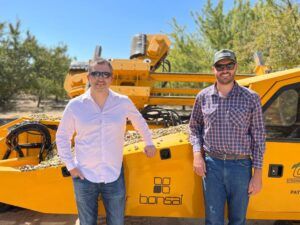Around the world, achieving ‘net zero’ emissions by the middle of this century has become a rallying cry to keep climate change in check and avoid its worst impacts.
Over 120 countries — from highly industrialized nations like Canada, Germany, and the UK to developing economies such as Myanmar, Sudan, and Tuvalu — have set their sights on reducing greenhouse gas (GHG) emissions to less than the amount that can be captured, either naturally or through new technologies.
The private sector is getting in on the act too, with more than 2,300 businesses and 163 of the world’s biggest investors pledging to slash net emissions to nil, according to the UN’s Race to Zero campaign.
Much of the focus on meeting this target has been on making the biggest emitting sector, energy, less carbon-intensive. But with a recent global analysis finding that agrifood systems account for a third of global emissions, any climate action plan that does not include dramatic changes to the way the world produces and consumes food is bound to fail.
The good news is that solutions to cut food-related emissions already exist, from soil-friendly farming methods to low-methane alternative proteins and supply chains powered by renewables.
New ideas are being proposed too, from circular systems that recycle food waste to reducing emissions of nitrous oxide (N₂O) – 300 times more potent than carbon dioxide – using a trait naturally found in many staple crops.
The bad news is that achieving this will require transformation at multiple levels and across many sectors, including a rethink around the vast amount of public money given to the agricultural sector every year – more than $600 billion globally, according to the UK’s Overseas Development Institute.
It will be an uphill battle, but not impossible, experts tell AFN.
What is needed is a “radical redesign of the food system” instead of “incremental changes,” says Hannah van Zanten, an associate professor at Wageningen University in the Netherlands who is working on the ‘waste-to-feed-to-food’ circular system.
“I believe we can get to ‘net zero,’ but it requires innovation along the entire value chain,” said David Welch, co-founder of Synthesis Capital, a new foodtech-focused VC fund.
“You can’t just rely on companies blending the same ingredients together in slightly different ways. You need to go all the way up to the starting material and innovate with ‘net zero’ in mind.”
Climate-friendly farming methods
Proponents say this means starting with practices, such as agroecology and regenerative farming, which aim to care for the soil and shun the use of synthetic, chemical-based fertilizers and pesticides.
These techniques reduce fossil fuel use on farms and boost the potential of soil to store more carbon, says James Woodward, sustainable farming officer at Sustain, a UK nonprofit advocating on food and agriculture policies.
Synthetic fertilizers accounted for about 1,000 out of 7,145 metric tons of global on-farm GHG emissions in 2018, making it the second biggest emitter after livestock, according to a recent paper published in Environmental Research Letters by scientists from the UN, NASA, the International Energy Agency (IEA), and other institutions.
But Woodward claims that the UK government, which is hosting the next round of UN climate negotiations, is ignoring farming’s impact on climate change – as well as its potential for mitigation. He said he’d like future farm subsidies to go towards helping farmers transition to agroecology, and to ‘green recovery’ funds to integrate trees into farming systems.
Similarly, Nicole Lederer, co-founder and chair of US advocacy group Environmental Entrepreneurs (E2), wants the country’s Department of Agriculture to incentivize farmers to take up regenerative agriculture by ensuring the price of crop insurance reflects the lower risk of crop failure in farms adopting it.
According to Lederer, studies suggest that corn, soybean, and almond farmers using these techniques have seen their incomes increase from higher yields and savings on inputs. But the biggest potential comes from sequestering carbon into the soil – carbon that farmers can be paid for by third parties seeking to offset their own emissions.
While debate continues as to whether this potential windfall is realistic or an overestimate, a recent E2 report states that US growers could sequester the equivalent of the annual emissions of 64 coal-fired power plants into the soil if they adopt regenerative farming methods.
Regenerative ag is also a key political tool to get large swathes of the US involved in solving climate change, Lederer adds. She points out that the 2018 Farm Bill, which included incentives to sequester carbon, was passed by Congress with bipartisan support – making it something of a rarity in recent US political history.
High tech, low emissions
However, for farming to have a major impact on bringing down emissions it will be required to address the elephant (or cow) in the room: livestock.
Emissions caused by livestock burps, farts, and manure account for more than half of on-farm emissions, according to the Environmental Research Letters paper mentioned above.
This is why the new generation of alternative proteins will play a crucial role in food systems’ ‘net zero’ ambitions, says Emma Ignaszewski, corporate engagement project manager at the Good Food Institute (GFI.)
“Meat consumption per capita in the US is at an all time high and education for behavior change won’t solve this problem on its own,” but alt-proteins can tackle several problems at once, including climate change, antibiotic resistance, global hunger, and deforestation, she says.
Two new GFI-commissioned papers say plant-based meat analogs have a significantly lower carbon footprint than animal-derived proteins.
Cell-cultured meat doesn’t score quite so well due to the level of energy consumption currently required to produce it. However, if only renewable energy is used, these products would have a carbon footprint 17% lower than conventionally reared chicken meat, 52% lower than pork, and up to 92% lower than beef.
Energy mix is only one aspect of the whole value chain, says Synthesis’ Welch, who previously worked as director of science and technology at GFI.
“Very few companies in the alternative protein space are talking about ‘net zero’ in a detailed way. As these companies mature and start to look for exits, they’re going to need to do this in a lot more detail,” he says, adding that creating crops designed specifically for producing alt-proteins is an area “ripe for disruption.”
Companies such as Equinom and Benson Hill, for example, are developing crop varieties with a higher density of protein. This means they require less processing, which tends to be water and energy-intensive, to turn them into ingredients for the final product.
Welch is also excited by companies using fermentation to produce alt-proteins. Fermentation is adaptable to all types of environments and economies, and is likely to have fewer constraints when scaling in different communities, he adds.
Restore and reduce
Shifting diets would also stop the conversion of natural ecosystems to farmland or pastures. Between 1990 and 2018, this was the largest single emissions source in the food system, the authors of the aforementioned Environmental Research Letters paper say.
In Latin America and the Caribbean, land use change is the single biggest source of GHG emissions across all sectors, according to Initiative20x20, which aims to protect and restore 50 million hectares of land by 2030.
Rapid agricultural expansion, driven by market demand for beef and crops such as coffee and sugarcane, is threatening the region’s forest cover, says Rene Zamora-Cristales, the initiative’s Latin America research coordinator.
“The narrative is that restoring forests is good because it produces oxygen and captures carbon, but the market doesn’t value those things,” he says.
“If I go to a company with that argument, they’ll say, ‘That sounds really nice but nobody’s paying for that.’ But if I tell them this can mitigate something that will affect their income, it becomes an investment.”
He now persuades plantation owners to restore forests on some of their land because it can reduce losses from seasonal flooding. The carbon sequestration potential is significant too.

For instance, a combination of reforestation, restoration, and avoided deforestation across 251 million hectares could store 2.5 gigatons of carbon dioxide equivalent a year in a region that emitted 4.6 gigatons in 2012, according to a UN report from 2015.
For many, the amount of resources that goes into producing, processing, and transporting food is precisely why food waste, which currently stands at nearly 1 billion tons or 17% of available food, is a major problem.
“At each stage of the value chain from the farm to our house, there are greenhouse gases being emitted, not to mention when that food is potentially thrown in the landfill and releases new gases in the atmosphere,” says Alexandria Coari, vice-president of ReFED, a non-profit focused on reducing food waste in the United States.
In the US, food waste is the number one material in landfills, and uneaten food contributes to 4% of the country’s GHG emissions, or around 270 million metric tons, according to ReFED.
In February, ReFed published an analysis listing 42 solutions, including avoiding overproduction and adjusting portion sizes, to halve food waste over the next decade and cut emissions by 75 million metric tons per year.
Getting to ‘net zero’ will “require us to streamline our food system, making sure we’re not overshooting our production or demanding more than we can actually sell or eat,” Coari says.
‘Radical redesign’
For the past five years, van Zanten and her team at Wageningen University have been working on a circular food systems model to do exactly that.
They are reusing or recycling waste – not just from kitchens but also from production and processing – to create diets that stay within planetary boundaries while meeting nutritional needs.
She calls it “a radical redesign of the food system” because the role of animals in the model is mainly to convert products humans cannot, or do not want, to eat – in other words, food which would’ve ended up being wasted – into protein. Conventionally, animals are fed a lot of grains that humans can eat, she adds.
Van Zanten and her team have developed three ‘circularity diets’ – which are high in vegetables, legumes, and nuts, but also include red meat and dairy – for the EU that could reduce GHG emissions by up to 31% and land use by up to 42%. The findings are currently under peer review.
Unsurprisingly, these diets are high in vegetables, legumes, and nuts, and low in meat. Notably, however, the diets include more beef, pork, and dairy than might have been expected; this is because chickens tend to be pickier eaters than other livestock, reducing the potential for feeding them waste products, says van Zanten.
“It’s nice to provide a one-liner, ‘Don’t consume beef. Let’s just eat chicken meat and the world will be fine.’ But food systems are complicated,” she adds.
“With this research, we showed you can consume a certain amount of animal-sourced food, but there is a limit. As soon as the waste is gone, you start to feed animals again with human foods.”
No need for ‘magical solutions’
Many improvements can be made to animal agriculture without imagining “magical solutions like half the world becoming vegan”, says Timothy Searchinger, lead author of a recent report on how Denmark’s agricultural sector can become carbon neutral by 2050.
Searchinger, who is the technical director of the food program at the World Resources Institute (WRI), and his team spent 18 months poring over the minutiae of Danish agriculture and emissions. They came up with a roadmap where promising technologies could reduce 80% of ‘excess’ emissions, and reforestation and restoring peatlands could eliminate the remaining 20%.
At the same time, productivity would also rise by 45% – which also happens to be WRI’s projected increase in food demand from 2017 to 2050.
The report recommends solutions – such as crop shifting, novel uses of grasses, and taking advantage of crop traits that suppress N₂O emissions – which are “highly applicable to almost any advanced agricultural economy” because they are cheap or profitable enough to be broadly adopted, Searchinger says.
“Denmark is like Iowa plus Seattle or San Francisco. It’s got a completely modern non-agricultural economy […] but the entire landscape is devoted to intensive agriculture,” he says. “Some people say the easiest way to comply with climate solutions is to get rid of Danish agriculture […] But the problem is we then have to produce the food somewhere else.”
A key concept is ‘land-area carbon neutrality,’ which seeks to reduce the clearing of new land for agricultural use while boosting the productivity of existing farm hectares. This is possible, but requires technological roadmaps, detailed planning, and investment in research and new technologies, the WRI report states.
There needs to be more urgency too, Searchinger adds, recounting the example of a Danish researcher who discovered methane emissions from manure could be reduced significantly by adding a small amount of sulfate.
“He’s had to wait years to get a small pilot study to test that. If this was Apple, they would have instantly seized on the result and funded five tests in a year,” he says.
Searchinger says he was unsure if carbon-neutral agriculture would be feasible when he first started working on the WRI report. But he was surprised and pleased to learn that it is.
“The key point is that we all basically need to do everything we can. The production sector has to do as much as it can and the processing and consumption sectors have to do as much as they can.”




